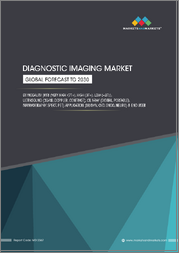
|
시장보고서
상품코드
1619162
맘모그래피 시장 규모, 점유율, 성장 분석 : 유형별, 제품별, 기술별, 최종 용도별, 지역별 - 산업 예측(2024-2031년)Mammography Market Size, Share, Growth Analysis, By Type (Screening Mammography, Diagnostic Mammography), By Product (Film Screen Systems, Digital Systems), By Technology, By End Use, By Region - Industry Forecast 2024-2031 |
||||||
세계의 맘모그래피 시장 규모는 2022년에 200만 달러로 평가되며, 2023년 220만 달러에서 2031년에는 463만 달러로 성장하며, 예측 기간(2024-2031년)의 CAGR은 10.1%로 성장할 전망입니다.
유방암 발병률 증가와 조기 발견에 대한 수요 증가는 유방암 검진 기기 시장의 주요 촉진요인입니다. 전 세계 인구의 고령화로 인해 60세 이상 여성이 유방암 관련 사망의 약 78%를 차지할 만큼 큰 비중을 차지하게 됩니다. 이 연령층은 높은 이환율과 사망률이 특징이며, 이는 효과적인 진단법에 대한 미충족 수요가 높다는 것을 의미합니다. 노인 인구 증가는 유방암 검진 솔루션에 대한 수요를 증가시킬 가능성이 높습니다. 또한 신제품 개발을 포함한 기술 발전은 더 많은 최종사용자를 끌어들일 것으로 예상됩니다. 기존 유방 촬영 시스템은 이미지 해석에 있으며, 어려움을 겪고 있으며, 이는 정확도와 환자 결과를 개선하기 위한 진단 툴의 개선 필요성을 강조하고 있습니다.
목차
서론
- 조사의 목적
- 조사 범위
- 정의
조사 방법
- 정보 조달
- 2차 데이터와 1차 데이터 방법
- 시장 규모 예측
- 시장의 전제조건과 제한
개요
- 세계 시장 전망
- 공급과 수요의 동향 분석
- 부문별 기회 분석
시장 역학과 전망
- 시장 개요
- 시장 규모
- 시장 역학
- 촉진요인과 기회
- 억제요인과 과제
- Porter의 산업 분석과 영향
- 경쟁 기업 간 경쟁 관계
- 대체품의 위협
- 바이어의 교섭력
- 신규 진출업체의 위협
- 공급 기업의 교섭력
주요 시장 인사이트
- 주요 성공 요인
- 경쟁의 정도
- 주요 투자 기회
- 시장 에코시스템
- 시장의 매력 지수(2023년)
- PESTEL 분석
- 거시경제 지표
- 밸류체인 분석
- 가격 분석
- 기술의 진보
- 규제 상황
- 사례 연구
맘모그래피 시장 규모 : 유형별 및 CAGR(2024-2031년)
- 스크리닝 맘모그래피
- 진단 맘모그래피
맘모그래피 시장 규모 : 제품별 및 CAGR(2024-2031년)
- 필름 스크린 시스템
- 디지털 시스템
- 아날로그 시스템
- 3D 시스템
맘모그래피 시장 규모 : 기술별 및 CAGR(2024-2031년)
- 유방 토모신테시스
- CAD 맘모그래피
- 디지털 맘모그래피
맘모그래피 시장 규모 : 최종 용도별 및 CAGR(2024-2031년)
- 병원
- 전문 클리닉
- 진단 센터
- 기타
맘모그래피 시장 규모 : 지역별 및 CAGR(2024-2031년)
- 북미
- 미국
- 캐나다
- 유럽
- 영국
- 독일
- 스페인
- 프랑스
- 이탈리아
- 기타 유럽 지역
- 아시아태평양
- 중국
- 인도
- 일본
- 한국
- 기타 아시아태평양
- 라틴아메리카
- 브라질
- 기타 라틴아메리카 지역
- 중동 및 아프리카
- GCC 국가
- 남아프리카공화국
- 기타 중동 및 아프리카
경쟁 정보
- 상위 5사의 비교
- 주요 기업의 시장 포지셔닝(2023년)
- 주요 시장 기업이 채택한 전략
- 시장의 최근 동향
- 기업의 시장 점유율 분석(2023년)
- 주요 기업의 기업 개요
- 회사 개요
- 제품 포트폴리오 분석
- 부문별 점유율 분석
- 매출의 전년대비 비교(2021-2023년)
주요 기업 개요
- GE Healthcare
- Hologic, Inc.
- Konica Minolta Business Solutions India Private Limited
- BMI Biomedical International SRL
- Canon Inc
- FUJIFILM Holdings Corporation
- GENERAL MEDICAL ITALIA
- Siemens Healthcare
- Villa Systems Medical SpA.
- Metaltronica
결론과 권장사항
KSA 25.01.15Global Mammography Market size was valued at USD 2 million in 2022 and is poised to grow from USD 2.2 million in 2023 to USD 4.63 million by 2031, growing at a CAGR of 10.1% in the forecast period (2024-2031).
The rising incidence of breast cancer and the growing demand for early detection are key drivers for the breast cancer screening devices market. As global populations age, a significant portion of women will be aged 60 and older, who represent approximately 78% of breast cancer-related deaths. This demographic is characterized by high rates of incidence and mortality, indicating a substantial unmet need for effective diagnostics. The increasing number of senior citizens will likely boost demand for breast screening solutions. Moreover, advancements in technology, including the development of new product offerings, are expected to attract more end users. Previous mammography systems faced challenges in image interpretation, highlighting the need for improved diagnostic tools to enhance accuracy and patient outcomes.
Top-down and bottom-up approaches were used to estimate and validate the size of the Global Mammography market and to estimate the size of various other dependent submarkets. The research methodology used to estimate the market size includes the following details: The key players in the market were identified through secondary research, and their market shares in the respective regions were determined through primary and secondary research. This entire procedure includes the study of the annual and financial reports of the top market players and extensive interviews for key insights from industry leaders such as CEOs, VPs, directors, and marketing executives. All percentage shares split, and breakdowns were determined using secondary sources and verified through Primary sources. All possible parameters that affect the markets covered in this research study have been accounted for, viewed in extensive detail, verified through primary research, and analyzed to get the final quantitative and qualitative data.
Global Mammography Market Segmental Analysis
Global Mammography Market is segmented by Type, Product, Technology, End Use and Region. Based on Type, the market is segmented into Screening Mammography, and Diagnostic Mammography. Based on Product, the market is segmented into Film Screen Systems, Digital Systems, Analog Systems, and 3D Systems. Based on Technology, the market is segmented into Breast Tomosynthesis, CAD Mammography, and Digital Mammography. Based on End Use, the market is segmented into Hospitals, Specialty Clinics, Diagnosis Centers, Others. Based on Region, the market is segmented into North America, Europe, Asia Pacific, Latin America and Middle East & Africa.
Driver of the Global Mammography Market
The global mammography market is primarily driven by the rising incidence of breast cancer worldwide. As breast cancer ranks among the most prevalent cancers affecting women, the emphasis on early detection and prevention has become paramount. Consequently, healthcare organizations and governments are implementing screening programs to promote regular breast examinations, particularly in developed nations. This heightened awareness surrounding the importance of early diagnosis has triggered a significant demand for advanced breast screening technologies and facilities, fostering growth in the marketplace. The urgent need for effective screening solutions is expected to continue to shape the evolution of the mammography market in the coming years.
Restraints in the Global Mammography Market
The global mammography market faces significant restraints, primarily due to the high costs associated with advanced breast screening equipment, such as digital and 3D imaging systems. These sophisticated technologies require substantial financial investments, which can be a barrier for smaller healthcare institutions, particularly in developing regions. This financial hurdle hinders widespread implementation and limits market growth in various areas. Moreover, despite ongoing advancements in breast screening technology, the prohibitive expenses related to acquiring and maintaining these advanced systems remain a major limitation, restricting their accessibility and ultimately curtailing the potential expansion of the mammography market.
Market Trends of the Global Mammography Market
The Global Mammography market is experiencing a significant shift towards the integration of Artificial Intelligence (AI)-assisted technologies in breast screening procedures. This trend leverages AI's capabilities to enhance the accuracy and speed of mammogram analysis, enabling radiologists to detect subtle abnormalities that may be missed during traditional manual evaluations. As healthcare continues to prioritize early detection and precision, the adoption of AI tools not only reduces human error but also streamlines workflow, leading to improved patient outcomes. The growing focus on technological innovations signals a transformative era in mammography, fostering advancements that are likely to reshape the landscape of breast cancer screening.
Table of Contents
Introduction
- Objectives of the Study
- Scope of the Report
- Definitions
Research Methodology
- Information Procurement
- Secondary & Primary Data Methods
- Market Size Estimation
- Market Assumptions & Limitations
Executive Summary
- Global Market Outlook
- Supply & Demand Trend Analysis
- Segmental Opportunity Analysis
Market Dynamics & Outlook
- Market Overview
- Market Size
- Market Dynamics
- Driver & Opportunities
- Restraints & Challenges
- Porters Analysis & Impact
- Competitive rivalry
- Threat of substitute
- Bargaining power of buyers
- Threat of new entrants
- Bargaining power of suppliers
Key Market Insights
- Key Success Factors
- Degree of Competition
- Top Investment Pockets
- Market Ecosystem
- Market Attractiveness Index, 2023
- PESTEL Analysis
- Macro-Economic Indicators
- Value Chain Analysis
- Pricing Analysis
- Technological Advancement
- Regulatory Landscape
- Case Studies
Global Mammography Market Size by Type & CAGR (2024-2031)
- Screening Mammography
- Diagnostic Mammography
Global Mammography Market Size by Product & CAGR (2024-2031)
- Film Screen Systems
- Digital Systems
- Analog Systems
- 3D Systems
Global Mammography Market Size by Technology & CAGR (2024-2031)
- Breast Tomosynthesis
- CAD Mammography
- Digital Mammography
Global Mammography Market Size by End Use & CAGR (2024-2031)
- Hospitals
- Specialty Clinics
- Diagnosis Centers
- Others
Global Mammography Market Size by Region & CAGR (2024-2031)
- North America (Type, Product, Technology, End Use)
- US
- Canada
- Europe (Type, Product, Technology, End Use)
- UK
- Germany
- Spain
- France
- Italy
- Rest of Europe
- Asia-Pacific (Type, Product, Technology, End Use)
- China
- India
- Japan
- South Korea
- Rest of Asia Pacific
- Latin America (Type, Product, Technology, End Use)
- Brazil
- Rest of Latin America
- Middle East & Africa (Type, Product, Technology, End Use)
- GCC Countries
- South Africa
- Rest of Middle East & Africa
Competitive Intelligence
- Top 5 Player Comparison
- Market Positioning of Key Players, 2023
- Strategies Adopted by Key Market Players
- Recent Developments in the Market
- Company Market Share Analysis, 2023
- Company Profiles of All Key Players
- Company Details
- Product Portfolio Analysis
- Company's Segmental Share Analysis
- Revenue Y-O-Y Comparison (2021-2023)
Key Company Profiles
- GE Healthcare
- Company Overview
- Business Segment Overview
- Financial Updates
- Key Developments
- Hologic, Inc.
- Company Overview
- Business Segment Overview
- Financial Updates
- Key Developments
- Konica Minolta Business Solutions India Private Limited
- Company Overview
- Business Segment Overview
- Financial Updates
- Key Developments
- BMI Biomedical International SRL
- Company Overview
- Business Segment Overview
- Financial Updates
- Key Developments
- Canon Inc
- Company Overview
- Business Segment Overview
- Financial Updates
- Key Developments
- FUJIFILM Holdings Corporation
- Company Overview
- Business Segment Overview
- Financial Updates
- Key Developments
- GENERAL MEDICAL ITALIA
- Company Overview
- Business Segment Overview
- Financial Updates
- Key Developments
- Siemens Healthcare
- Company Overview
- Business Segment Overview
- Financial Updates
- Key Developments
- Villa Systems Medical SpA.
- Company Overview
- Business Segment Overview
- Financial Updates
- Key Developments
- Metaltronica
- Company Overview
- Business Segment Overview
- Financial Updates
- Key Developments



















